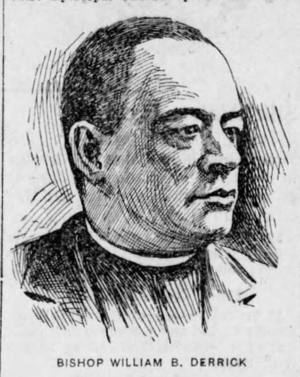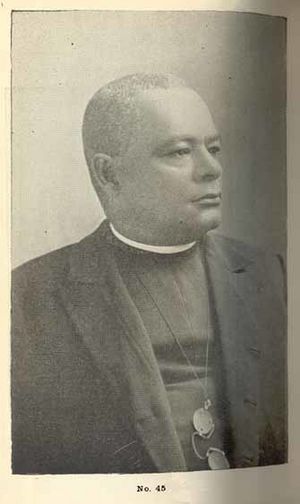William B. Derrick facts for kids
Quick facts for kids
William B. Derrick
|
|
|---|---|

Sketch of Derrick from newspaper article in 1900
|
|
| Born | July 27, 1843 |
| Died | April 15, 1913 (aged 69) |
| Occupation | Minister, civil rights activist |
| Religion | African Methodist Episcopal |
William B. Derrick (July 27, 1843 – April 15, 1913) was an important leader in the African Methodist Episcopal (AME) Church. He was a bishop and a missionary. Before his church work, he was a sailor and served in the Union Navy during the U.S. Civil War. After the war, he joined the AME church. He became a bishop in 1896. He also worked for civil rights and was involved in politics.
Contents
William B. Derrick was born on July 27, 1843, in Antigua. This island is in the British West Indies. His father came from a large family of planters there. William went to a public school run by Moravians from 1848 to 1856. Then he attended a private high school for three years. He trained to be a blacksmith.
After his training, he became a sailor. He served in the navy from 1861 to 1864. He was on the USS Minnesota. This ship was important during the Battle of Hampton Roads. In this battle, the Minnesota fought against the Merrimac and the Monitor. Naval records describe him as being five feet five inches tall. He had a tattoo of "W. B. D." on his right arm.
After his naval service, he married Mary E. White. Mary passed away, and he later married Lillian M. Lillian around 1882. She died in 1907. In 1909, he married Clara E. Henderson Jones.
Joining the AME Church
In 1866, William B. Derrick joined the African Methodist Episcopal (AME) Church. A church leader named John M. Brown allowed him to preach and work as a missionary. A missionary helps spread the church's message.
In 1867, Bishop Daniel A. Payne assigned Derrick to a church in Washington D.C. In 1868, he became a deacon. Later, he became an elder and a presiding elder. A presiding elder oversees several churches in a district. He was very active in church conferences throughout the 1870s. He became a presiding elder for a large area including New York, New Jersey, Pennsylvania, and New England. In 1888, he was chosen as the missionary secretary. This role meant he managed the church's missionary efforts.
In 1889, there was a problem with money for the mission in Haiti. Derrick, as missionary secretary, was in charge of these funds. He worked to fix the issue and improved his standing with church leaders.
In 1896, William B. Derrick was elected bishop. This is a very high position in the church. As a bishop, he was very important in the church's missionary work. In the early 1900s, Bishop Derrick traveled widely. He worked hard to help the AME Church grow in Africa.
Working for Civil Rights
Outside of his church work, William B. Derrick was very active in politics. He was a Republican. In 1884, he was nominated to be a presidential elector. This means he would have helped choose the president. He declined because some people questioned if he was a citizen. But he had become a citizen when he joined the navy many years before.
Derrick also bought part of a newspaper called the New York Globe in 1884. He wanted it to be a strong Republican newspaper. He worked with another editor, T. Thomas Fortune. They disagreed on how to run the paper.
Derrick was very active in civil rights at the end of the 1800s. He was a member of the Afro-American Council. This group worked for the rights of African Americans. Derrick and other AME leaders were important Republicans in the late 1890s and early 1900s. He supported women who wanted to preach in the church. In 1892, he spoke out against the Geary Act. This law was unfair to Chinese immigrants.
William B. Derrick was proud of his time in the military. He supported many military causes. He was one of the people who wanted action after the sinking of the USS Maine in 1898. This event helped lead to the Spanish–American War. He also gave a prayer at a big meeting of Civil War veterans in 1893. This meeting was at the Gettysburg Battlefield.
His speeches were often written about in newspapers. He received an honorary degree from Wilberforce University in 1885. He was friends with other important leaders like Bishop Richard H. Cain. He also worked with politicians like James G. Blaine, Benjamin Harrison, and William McKinley. Derrick often traveled to England and was a popular speaker there.
Besides the Globe, Derrick also owned a journal called the West Indian Abroad. He was part of several groups like the Odd Fellows and Masons. He was also a trustee for Wilberforce University. He was a close friend and supporter of Booker T. Washington. He stayed connected to people from Antigua living in New York and the West Indies throughout his life.
William B. Derrick passed away on April 15, 1913, in Flushing, New York.
Images for kids




